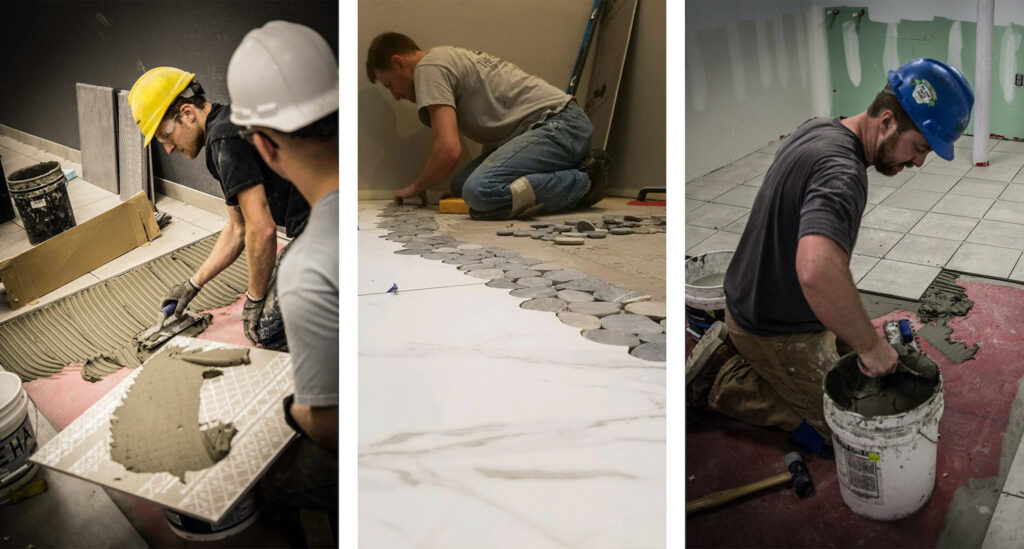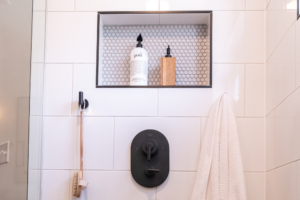Tile flooring is known for its durability, but even the strongest materials don’t last forever. If you’re noticing issues with your floors, it may be time to consider tile flooring replacement. Whether your tile is cracked, outdated, or simply worn down, replacing it can refresh your space and improve functionality.
For those concerned about their tile flooring in Milwaukee, WI, harsh winters and heavy foot traffic can take a toll over time. Identifying the warning signs early can help prevent further damage and costly repairs. So, how do you know when it’s time to replace your tile flooring? Let’s take a look at eight telltale signs.
Do You Need Tile Flooring Replacement?

Tile flooring is designed to last for decades, but certain issues indicate it’s time for a replacement rather than a repair. Below are eight key signs that your tile floor needs to be replaced.
1. Loose Tiles
When you step on your tile floor, do you feel some tiles shifting or moving underfoot? Loose tiles are a clear indication that the adhesive beneath has weakened. Over time, this can cause further deterioration and even pose a safety risk. While reattaching a few tiles is possible, widespread loosening often signals that the entire floor needs replacement.
2. Damaged Tiles
Cracks, chips, and fractures not only affect the look of your flooring but also its functionality. Damaged tiles can allow moisture to seep into the subfloor, leading to even more extensive damage. While individual tile repairs are possible, replacing the flooring entirely ensures a uniform, long-lasting solution.
3. Uneven Surface
An uneven tile floor can result from improper installation, shifting foundations, or years of wear and tear. You might notice dips, raised edges, or a generally wobbly feel when walking across the surface. Uneven flooring isn’t just unsightly—it can also be a tripping hazard. If your tile floor is no longer level, replacing it is the best way to restore safety and aesthetics.
4. Grout Problems
Grout holds your tiles in place and prevents moisture from seeping underneath. However, over time, grout can become discolored, cracked, or even start crumbling away. If regular cleaning and sealing no longer restore the look of your grout, or if you’re constantly dealing with repairs, a full tile replacement may be the best option.
5. Water Damage
Water is one of the biggest threats to tile flooring, especially in bathrooms and kitchens. If your tiles are starting to loosen, grout is deteriorating, or you see signs of mold growth, water damage may be the culprit. Once water reaches the subfloor, structural issues can arise, making replacement the safest and most effective solution.
6. Subfloor Concerns
Sometimes, the problem isn’t just with the tile itself—it’s what’s underneath. A damaged or deteriorating subfloor can cause tiles to shift, crack, or loosen. If your flooring feels unstable, replacing both the tile and subfloor ensures a solid foundation and prevents future problems.
7. Tile Stains
Persistent stains that won’t come out with traditional tile cleaning practices are a sign that your tile’s protective finish has worn away. Certain materials, like natural stone, are more prone to staining over time. If your tiles constantly look dirty or worn despite cleaning, it might be time to upgrade to new flooring.
8. Aesthetic Issues
Your tile floor may still be functional, but does it look outdated? Styles change over time, and what was trendy 20 years ago may not suit your current taste. If your tile flooring no longer matches your home’s aesthetic, replacing it can give your space a fresh, modern look.
How Much Does It Cost to Replace Tiling?

The cost of tile flooring replacement varies based on the type of tile, labor costs, and the size of the space. On average, homeowners in Milwaukee can expect to pay between $10 to $30 per square foot, including materials and installation. High-end tiles, such as marble or porcelain, will cost more than ceramic or vinyl options.
Other factors affecting cost include:
- The complexity of tile removal
- Subfloor repairs or replacement
- The type of tile chosen
- The size of the room
If you’re unsure about your budget, The Tile Group offers free consultations to help you determine the best solution for your space.
What Is the Lifespan of a Tile Floor?

A well-maintained tile floor can last 20 to 50 years, depending on the type of tile and the level of care it receives. Ceramic and porcelain tiles tend to have longer lifespans due to their durability, while natural stone requires more maintenance.
Factors that influence longevity include:
- Installation quality: Poor installation can lead to early failure.
- Maintenance: Regular cleaning and sealing extend the life of tile and grout.
- Foot traffic: High-traffic areas may wear down faster.
If your tile flooring is nearing the end of its lifespan, upgrading to a new installation ensures your home remains beautiful and functional for years to come.
Our Tile Flooring Projects
Tile Flooring Replacement in Milwaukee, WI
If your floors are showing signs of damage, unevenness, or outdated aesthetics, tile flooring replacement is the best way to restore your home’s beauty and safety. Whether you’re dealing with loose tiles, stubborn stains, or subfloor issues, replacing your flooring provides a long-term solution that enhances your space.
For expert tile flooring in Milwaukee, WI, The Tile Group is here to help. Contact us today for a free consultation and let our skilled team bring your vision to life!





